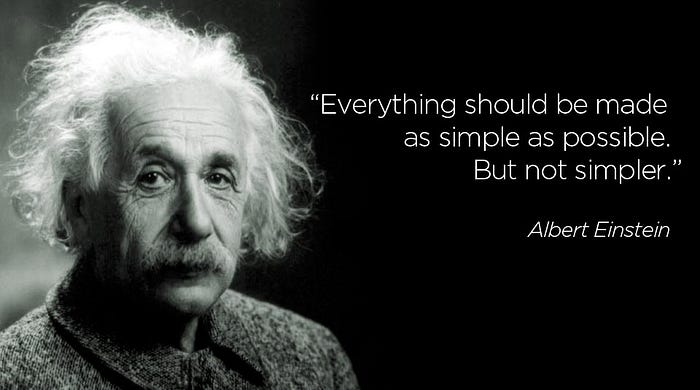Random finds (2016, week 19) — On wise leadership, why less isn’t always more, and deep work

Every Friday, I run through my tweets to select a few observations and insights that have kept me thinking over the last week.
The six abilities of wise leaders
In the May 2011 issue of Harvard Business Review, Ikujiro Nonaka, a professor emeritus at Tokyo’s Hitotsubashi University, and Hirotaka Takeuchi, a professor at Harvard Business School, wrote that “in an era when discontinuity is the only constant, the ability to lead wisely has nearly vanished. All the knowledge in the world did not prevent the collapse of the global financial system three years ago or stop institutions like Lehman Brothers and Washington Mutual from failing.”
According to Nonaka and Takeuchi, leaders find it hard to ensure that their people adhere to values and ethics. The prevailing principles in business make employees ask, “What’s in it for me?” Missing are those that would make them think, “What’s good, right, and just for everyone?” The purpose of business, executives still believe, is business, and greed is good so long as nobody finds out.
“The purpose of business is to create and keep a customer.” — Peter Drucker
For today’s leaders, knowledge is more critical than ever before. But in an age in which knowledge is abundant, and companies have learned to capture, store and distribute knowledge, why doesn’t knowledge result in wise leadership?
The problem is twofold, according to Nonaka and Takeuchi. Many leaders use knowledge improperly, and most don’t cultivate the right kinds. Managers tend to rely on explicit (over tacit) knowledge, because it can be codified, measured and generalized. But this dependence prevents them from coping with change. The scientific, deductive, theory-first approach assumes a world independent of context, and seeks answers that are universal and predictive. However, business, just as all other social phenomena, is context dependent. Analyzing this context without considering people’s goals, values, and interests along with the power relationships among them, is simply meaningless. Yet executives fail to do so.
The world needs leaders who will make judgments knowing that everything is contextual, make decisions knowing that everything is changing, and take actions knowing that everything depends on doing so in a timely fashion. They will have to see what is good, right, and just for society while being grounded in the details of the ever-changing front line.
Unless companies create social as well as economic value, they will not survive in the long run.
Studies done by Nonaka and Takeuchi over a 20-year period, show that the use of explicit and tacit knowledge isn’t enough. Leaders must also draw on a third, often forgotten kind of knowledge, called practical wisdom, which they define as ‘tacit knowledge acquired from experience that enables people to make prudent judgments and take actions based on the actual situation, guided by values and morals.’ When leaders cultivate such knowledge throughout the organization, they will be able not only to create fresh knowledge but also to make enlightened decisions.
To make these decisions, leaders must understand why a company exists. Companies often behave as though they’re willing to do anything to survive, even if that means destroying the world in which they operate. They would do better to pursue the common good — not because it’s right or fashionable but to ensure their sustainability.
No company will survive over the long run if it doesn’t offer value to customers, create a future that rivals can’t, and maintain the common good.
Of course, it isn’t easy to lead with practical wisdom. A wise leader must make judgments and take actions amid constant flux. And he or she must do so while taking a higher point of view — what’s good for society — even though that view stems from individual values and principles. To lead in this fashion, six abilities are essential:
- Wise leaders make decisions only after they figure out what is good for the organization and society.
- They can quickly grasp the essence of any situation or problem and intuitively fathom the nature and meaning of people, things, and events.
- They constantly create informal as well as formal shared contexts for senior executives and employees to construct new meaning through their interactions.
- They know how to use metaphors and stories to convert the essence of their actual experiences into tacit knowledge for individuals and groups.
- They exercise political power to bring together people with conflicting goals and spur them to action.
- They encourage the development of practical wisdom in others, especially employees on the front lines, through apprenticeship and mentoring.
Nonaka and Takeuchi conclude their article by expressing their belief that today’s knowledge-creating companies must metamorphose into the wisdom-practicing companies of tomorrow, and that, as a consequence, tomorrow’s CEOs must be many many things at the same time:
- a philosopher who grasps the essence of a problem and draws general conclusions from random observations;
- a master craftsman who understands the key issues of the moment and acts on them immediately;
- an idealist who will do what he or she believes is right and good for the company and society;
- a politician who can spur people to action;
- a novelist who uses metaphors, stories, and rhetoric;
- a teacher with good values and strong principles, from whom others want to learn.
This may sound idealistic but for companies to create new futures, their leaders cannot be content to analyze situations using empirical data and deductive reasoning. They must also make inductive jumps according to their ideals and dreams, while at the same time be pragmatic — looking reality in the eye, grasping the essence of a situation, and envisioning how it relates to the larger context. Leaders will have to become idealistic pragmatists, which is why they must turn the dual quest for knowledge and practical wisdom into a way of life.
In this 10-minute interview with Harvard Business Review’s Adi Ignatius, Nonaka and Takeuchi explain their ideas in more detail.
https://www.youtube.com/watch?v=Rp-cjRhWoV0
Ockham’s Razor or why Gaudí could get away with ‘more is more’
“Ockham’s Razor says that simplicity is a scientific virtue, but justifying this philosophically is strangely elusive,” Elliot Sober, a research professor in philosophy at the University of Wisconsin, Madison, writes in Why is simpler better?
“Entia non sunt praeter necessitatem multiplicanda.” — William of Ockham
Albert Einstein spoke for many scientists when he said that “it can scarcely be denied that the supreme goal of all theory is to make the irreducible basic elements as simple and as few as possible without having to surrender the adequate representation of a single datum of experience.”
“The search for simple theories,” Sober writes, “is a requirement of the scientific enterprise. When theories get too complex, scientists reach for Ockham’s Razor, the principle of parsimony, to do the trimming. This principle says that a theory that postulates fewer entities, processes or causes is better than a theory that postulates more, so long as the simpler theory is compatible with what we observe. But what does ‘better’ mean? It is obvious that simple theories can be beautiful and easy to understand, remember and test. The hard problem is to explain why the fact that one theory is simpler than another tells you anything about the way the world is.”

Other than scientists, artists don’t try to discover the uniquely correct degree of complexity that all artworks should have. There is no such timeless ideal. “If all art should be simple or if all art should be complex, the choice is clear. However, both of these norms seem absurd. Isn’t it obvious that some estimable art is simple and some is complex? True, there might be extremes that are beyond the pale; we are alienated by art that is far too complex and bored by art that is far too simple. However, between these two extremes there is a vast space of possibilities,” Sober writes.
If you have ever been to Barcelona, you no doubt have seen Antoni Gaudí’s flamboyant and complex Sagrada Família. Only a few miles down the road, you’ll find a perfect example of Mies van der Rohe’s minimalist architecture: his German National Pavilion for the Barcelona International Exhibition (1929). The contrasts between these two iconic building can’t be more startling. If Ockham’s Razor would dictate the arts as it does science, the Sagrada Família would never have been built. But in contrast to Van der Rohe’s ‘less is more’, we have Gaudí’s ‘more is more’, and both work wonderfully well.


Both architects remind us that there is no disputing matters of taste when it comes to assessing the value of simplicity and complexity in works of art. Einstein and Newton on the other hand, say that science is different — simplicity, in science, is not a matter of taste. And, as it turns out, this is not entirely without reasons. The upshot, according to Sober, is that there are three parsimony paradigms that explain how the simplicity of a theory can be relevant to saying what the world is like:
Paradigm 1: sometimes simpler theories have higher probabilities.
Paradigm 2: sometimes simpler theories are better supported by the observations.
Paradigm 3: sometimes the simplicity of a model is relevant to estimating its predictive accuracy.
“These three paradigms have something important in common,” Sober concludes. “Whether a given problem fits into any of them depends on empirical assumptions about the problem. Those assumptions might be true of some problems, but false of others. Although parsimony is demonstrably relevant to forming judgments about what the world is like, there is in the end no unconditional and presuppositionless justification for Ockham’s Razor.”
On innovation
As always quite a few articles on innovation, but for me, these four stood out, including a 2002 Harvard Business Review classic by Peter Drucker:
• There Is No One True Path To Innovation by Greg Satell on Forbes: “We need to leave to leave behind the innovation fairy tales and deal with innovation as it really happens. Coming up with the ‘next big thing’ is less a matter of epiphany and more a matter of identifying the right set of tools for the right job.”
• To Innovate, You Have to Manage the Past, Present, and Future, a 10-minute video interview with Vijay Govindarajan on Harvard Business Review. Govindarajan, professor at the Tuck School of Business at Dartmouth College, explains how to create a new business while optimizing an already existing one.
• Cognitive Bias and Innovation: How Can We Combat Instinct? by Phil McKinney: “We are often uncomfortable with radical change, or assume that something that has always had a certain function can’t have a different function. These biases against change are a fundamental part of how we operate: the laws of inertia in our subconscious.”
• The Discipline of Innovation by Peter Drucker on Harvard Business Review (2002).
“Innovation requires knowledge, ingenuity, and, above all else, focus.” — Peter Drucker
A bit more …
“I’d assume most executives and senior decision-makers, when preaching a sense or urgency to their lieutenants on any topic or project, will probably talk in some form or fashion about the first-mover advantage. Essentially, they’re telling their people ‘We gotta get there first. We gotta capture that market share.’ This is logical, because business tends to deify war, and in war planning, ‘getting there first’ makes a lot of sense. The problem is, it’s not really true in business planning.”
Sense of urgency is a managerial synonym for “I didn’t really want to deal with this.”
According to Ted Bauer, when tied back to the first-mover advantage concept, the sense of urgency concept is flawed. Also Adam Grant, in a recent TEDTalk about the surprising habits of original thinkers, mentions (near the end) that first-mover advantage is actually is a farce. Oftentimes the third or fourth company into a market wins it, which is logical. That fourth company in can iterate on the first three and correct their mistakes.
Read on The Context of Things : http://thecontextofthings.com/2016/04/17/sense-of-urgency-managerial-trick.
For its all fury and fanfare, brutalism was a mere speck in architectural history; a 20-year experiment from 1955 to 1975 that produced some interesting outcomes and some downright weird cityscapes. Modernism is over, our faith in the future is damaged, and architecture today should just respond to what’s already there rather than creating brave new worlds built from great cliffs of exposed concrete and multiple, vertiginous levels. At least, according to today’s conventional wisdom. But cities of the future would do well to learn from brutalism.

Today’s cities are filled with buildings that retreat, that cough and splutter. Brutalist buildings asserted themselves and looked right. They were tough and iconic without even trying. They were also architecture as pure art — sculptural and abstract forms that tested the viewer. We need more of that.
Brutalist buildings looked to the future. They were an investment in the city, showing great vision and optimism.
One of the many things that cities can really learn from brutalism is faith. Brutalism was an act of faith, a song to the city. It was rough and tough but so are cities — they’re not the countryside. If we built like this again it would say that we love our cities and we see them as places that can be exciting, innovative, fair, prosperous and long-lasting.
Read on TheLong+Short: http://thelongandshort.org/cities/what-can-cities-of-the-future-learn-from-brutalism.
Why must we all work long hours to earn the right to live? Well, Bertrand Russel and Richard Buckminster Fuller clearly thought otherwise. Fuller articulated his ideas on work and non-work throughout his long career:
“It is a fact today that one in ten thousand of us can make a technological breakthrough capable of supporting all the rest. […] We keep inventing jobs because of this false idea that everybody has to be employed at some kind of drudgery because, according to Malthusian-Darwinian theory, he must justify his right to exist.”

Instead, Fuller thought we should all work for ourselves, performing the kind of labor we deem necessary for our quality of life and our social arrangements, rather than the kinds of labor dictated to us by others. He believed all of us could do so, and that we would flourish similarly. Fuller called the technological and evolutionary advancement that enables us to do more with less ‘euphemeralization.’ In Critical Path, a visionary work on human development, he claimed “It is now possible to give every man, woman and child on Earth a standard of living comparable to that of a modern-day billionaire.”
This may sound utopian but, Fuller, and of course also Russel were ahead of their time. In the light of the rise of artificial intelligence and machine learning, and their, no doubt, huge impact on human work, the debate around basic income is rapidly gaining ground.
Read on Open Culture: http://www.openculture.com/2015/10/bertrand-russell-buckminster-fuller-on-why-we-should-spend-less-time-working.html.
More Buckminster Fuller in Dymaxion Man, a 2008 New Yorker article by Elizabeth Kolbert: http://www.newyorker.com/magazine/2008/06/09/dymaxion-man.
“The purpose of looking at the future is to disturb the present.” — Gaston Berger
